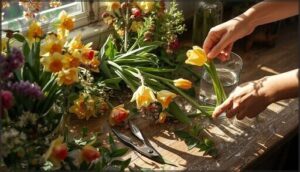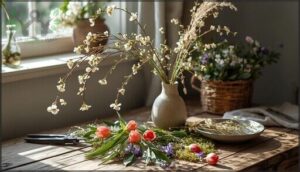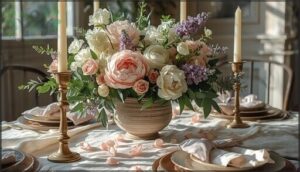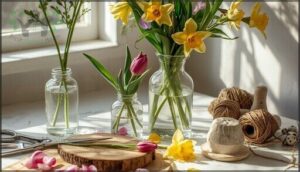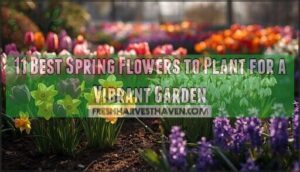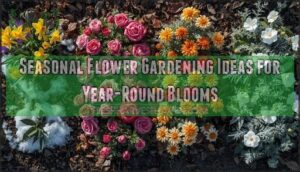This site is supported by our readers. We may earn a commission, at no cost to you, if you purchase through links.

There’s something almost electric about the first warm day of spring, when you can finally throw open the windows and bring armfuls of fresh blooms inside. If you’ve ever stood in your garden with scissors in hand, wondering how to transform those beautiful stems into something that doesn’t look like a confused grocery store bouquet, you’re not alone.
The secret to a stunning spring garden flower arrangement isn’t some mysterious talent—it’s understanding a few key principles about balance, color, and how flowers actually want to move. When you learn to work with your blooms instead of forcing them into rigid symmetry, something magical happens: those tulips that kept flopping over suddenly become part of the arrangement’s charm, and that handful of daffodils transforms into something worthy of your dining room table.
Let’s walk through exactly how to make that happen.
Table Of Contents
- Key Takeaways
- Essential Spring Flowers for Arrangements
- Choosing The Right Color Palette
- Preparing Flowers for Arranging
- Selecting Creative Vessels and Containers
- Arranging Flowers Step by Step
- Incorporating Natural and Foraged Elements
- Spring Centerpiece Ideas for Every Occasion
- Flower Arrangement Techniques and Tools
- Sustainable and Seasonal Flower Choices
- Health and Mood Benefits of Spring Flowers
- Frequently Asked Questions (FAQs)
- Conclusion
Key Takeaways
- The secret to stunning spring arrangements isn’t rigid symmetry but understanding balance, color theory, and working with how flowers naturally move—letting tulips flop and daffodils arch creates charm rather than fighting their nature.
- Proper flower prep makes the difference between arrangements that wilt overnight and ones lasting two weeks: cut stems at 45-degree angles early morning, pre-soak daffodils separately for 4-6 hours to prevent their toxic sap from harming other blooms, and refresh water every 2-3 days.
- Choosing local, seasonal flowers cuts your carbon footprint while delivering longer-lasting, more vibrant arrangements—plus you’ll discover unique varieties and support community growers who use fewer chemicals.
- Spring flowers deliver measurable wellness benefits beyond beauty: just four minutes viewing natural arrangements lowers anxiety, while the act of arranging blooms reduces stress hormones and sharpens cognitive function.
Essential Spring Flowers for Arrangements
Spring is when gardens wake up and offer us the best blooms for arrangements that feel alive and full of promise. Knowing which flowers to choose makes all the difference between a nice bouquet and one that truly captures the season’s energy.
Let’s look at the essential spring flowers that will help you create arrangements worth showing off.
Popular Spring Blooms (Tulips, Daffodils, Hyacinths)
When you’re creating spring flower arrangements, tulips, daffodils, and hyacinths are your go-to trio. Tulips—ranked third among the world’s most beloved blooms—bring bold, phototropic stems that chase the light. Daffodils naturalize beautifully and resist deer, while hyacinths infuse spaces with intoxicating fragrance. Together, they dominate the spring market and offer endless possibilities for weaving color, texture, and symbolism into your designs.
For example, Darwin Hybrid Tulips are excellent for bouquets due to their long stems.
Early-Spring Flowers (Paperwhites, Narcissus, Bluebells)
Before tulips steal the show, early spring flowers like paperwhites, narcissus, and bluebells quietly announce the season’s arrival. Forcing paperwhites indoors is simple—no chilling needed—and their narcissus fragrance fills rooms for up to a month when kept cool. Bluebells thrive in woodland-style arrangements, their bluebell ecology creating natural texture. Paperwhites are easy to force since they don’t need chilling, and you can purchase blemish-free bulbs to avoid basal rot.
Try these tips for arranging flowers at home:
- Group bulbs for maximum scent and visual impact (bulb grouping)
- Keep paperwhites at 60–65°F for floral longevity
- Pre-soak stems before weaving them into creating spring flower arrangements
Unique Additions (Poppies, Delphinium, Larkspur)
For something unexpected, poppies bring bold citrus tones to your spring flower arrangements—though their vase life spans just 2 to 5 days, so harvest buds as they open.
Delphinium cultivation rewards you with rare blue-violet spikes reaching 40 inches, while larkspur colors span pink to purple, adding unique structure.
These stems respond to seasonal demand from February through May, perfect for unique flower arrangement ideas when you’re arranging flowers at home.
Incorporating Foliage and Branches
Beyond blooms, foliage textures and branch structure transform your spring flower arrangements into something sculptural. Cherry blossoms and forsythia add height while symbolizing renewal—perfect for seasonal symbolism that speaks to fresh starts.
You’ll love the cost-effectiveness of backyard branches paired with silver dollar eucalyptus or variegated pittosporum, creating garden aesthetics that feel both wild and intentional through strategic floral design.
Choosing The Right Color Palette
Color sets the mood for your entire arrangement, and spring gives you a world of possibilities to play with. You can go bold with citrus brights and jewel tones, or lean into whisper-soft pastels that feel like a morning garden.
Let’s explore how different color approaches can transform your arrangements from pretty to unforgettable.
Vibrant Vs. Soft Spring Tones
The color palette you choose for your spring floral arrangements speaks volumes before you even pick up a flower. Color psychology plays a major role in design impact and mood association. Vibrant colors like sunny yellows and hot pinks radiate energy and cheerfulness, while pastel colors—soft blues, light greens, and blush pinks—bring calm and renewal. Each tone combination carries symbolic meanings that transform your spring flower colors into emotional experiences.
- Vibrant hues: Corals, tangerines, and bold yellows create excitement and activity
- Soft pastels: Periwinkle blues and mint greens evoke serenity and hope
- Blue tones: Most preferred spring shade, offering tranquility and trust
- Warm palettes: Yellow daisies with orange gerberas deliver inviting, cheerful vibes
Creating Ombré and Monochrome Effects
For elegance that wows, try ombré color gradients or monochrome texture emphasis—two floral design techniques that feel fresh and modern. Start with palest blooms like cream lisianthus, building intensity through mid-tones until you reach your deepest hues. This tonal flower selection creates stunning single-hue harmony. Hydrangeas and calla lilies excel here, their natural gradients practically doing the work for you.
| Ombré Technique | Monochrome Approach |
|---|---|
| Lightest blooms at one end | Single color palette throughout |
| Mid-tones anchor the center | Emphasizes texture over color |
| Darkest hues create drama | Uses varied flower shapes |
| Natural fade between shades | Minimalist, sophisticated appeal |
| Best with multi-tonal petals | Popular in modern home decor |
Monochrome arrangements spotlight form instead of bright colors—think all-white tulips or deep purple irises creating grayscale flower arrangements that let every petal shine.
Color Symbolism in Spring Flowers
When you’re choosing spring flowers for your arrangements, think beyond bright colors—each hue whispers its own story. Red passion speaks through tulips symbolizing love, while yellow cheer radiates from daffodils promising happiness. White purity shows in hyacinths, blue calm flows through delphiniums, and purple luxury crowns irises.
Every spring flower color tells its own story—red tulips whisper passion, yellow daffodils radiate joy, and white hyacinths embody pure serenity
Understanding color symbolism transforms simple flower arrangements into meaningful expressions.
Preparing Flowers for Arranging
Before you start arranging, you need to treat your flowers right so they’ll stay fresh and vibrant for days. A few simple prep steps can make the difference between blooms that wilt by tomorrow and ones that last through the week.
Here’s what you need to know to give your spring flowers the best possible start.
Proper Cutting and Conditioning Techniques
Want your spring flowers to last longer than a long weekend? Start by cutting stems early in the morning when it’s cool—this reduces shock and extends vase life. Use sharp floral snips and slice at a 45-degree angle to boost stem hydration.
Then, place your fresh flowers in warm water overnight. This simple conditioning lets seasonal blooms drink deeply, setting up gorgeous flower arrangements that actually stick around.
Pre-soaking Daffodils and Other Special Care
Daffodils have a dirty little secret—their sap is toxic to other spring flowers. Pre-soaking duration matters: give them 4 to 6 hours in cool water, solo, before mixing.
This separate conditioning lets the harmful slime leach out, protecting your tulips and hyacinths. Best practices? Keep daffodils in their own bucket, change the water once, then blend them freely for arrangement longevity that actually lasts.
Maximizing Flower Longevity
Think of flower care as preventative medicine—small habits make all the difference. Recut stems at a 45-degree angle every two to three days to keep water flowing freely. Fresh vases and clean water every 48 hours prevent bacterial buildup that shortens bloom life.
Keep arrangements cool, away from direct sunlight and ripening fruit. These handling practices and environmental placement choices turn week-long displays into two-week showstoppers.
Selecting Creative Vessels and Containers
The vessel you choose can make or break your arrangement, and you’re not limited to the usual glass vase sitting in your cabinet.
Spring is the perfect time to get playful with containers, from heirloom pieces that add character to unexpected finds that spark conversation.
Let’s explore how traditional options and creative alternatives can transform your flowers into something truly special.
Traditional Vases and Urns
From their urn historical significance as 15th-century garden vessels to today’s urn aesthetic trends, traditional vases and urns bring timeless romance to spring flower arrangements.
You’ll find vase material types like glass, ceramic, and stone perfect for arranging flowers, while popular vase shapes—cylinders, bowls, and tapered designs—complement your floral display beautifully.
Consider practical urn considerations like weight and water-holding liners for stunning results.
Unique Options (Eggshells, Teapots, Fishbowls)
Beyond traditional options, you’ll discover charming alternatives that showcase flower arrangement techniques with personality. Eggshell fragility creates delicate DIY floral arrangements—perfect for tiny violets or grape hyacinths in egg cups. Vintage teapot aesthetics bring nostalgia to centerpieces, while fishbowl visibility adds modern drama by displaying stems beneath your blooms.
These creative vases offer container sustainability and novelty pricing that makes using various containers for flowers both eco-friendly and budget-conscious.
Using Everyday Items as Flower Holders
You don’t need fancy vases to create beautiful centerpieces—mason jars, vintage tins, and even woven baskets work wonderfully as repurposed vessels. These budget-friendly holders add character to your home decor while supporting sustainability.
Try placing a glass jar inside a woven basket for hidden water storage, or stretch tape across jar openings to guide stems into place. These creative alternatives transform DIY containers into stunning focal points.
Arranging Flowers Step by Step
Now that you’ve got your flowers prepped and your vessel ready, it’s time to put it all together. The actual arranging part doesn’t have to be intimidating—it’s really about layering in stems with a bit of intention and an eye for balance.
Let’s walk through a few simple techniques that’ll help you create arrangements that look effortlessly beautiful.
Creating a Balanced Arrangement
Creating spring flower arrangements feels a lot like composing music—you’re balancing elements until everything sings together. Floral design techniques involve understanding both visual weight and container impact to make your blooms shine.
- Symmetry vs. Asymmetry: Choose formal balance or modern artistry based on your occasion
- Flower-Foliage Ratio: Aim for roughly 60% focal flowers, 20% fillers, 20% greenery
- Height Placement: Position stems at 1.5 times your vase height
- Odd Numbers: Group blooms in threes or fives for natural appeal
- Container Impact: Match vessel size to arrangement scale for stability
Building Height and Depth
With height proportions in mind, you’ll want your tallest blooms to reach roughly 1.5 to 2 times your container’s height—that’s where visual drama begins.
Layering techniques bring depth: position taller flowers toward the back, medium stems in the middle, and shorter blooms up front. This structural role creates dimension in vase arrangements, especially when you use floral foam for stability and incorporate balanced ratios throughout your springtime floral displays.
Massing Flowers for Lushness
Grouping blooms tightly unlocks true lushness in your springtime floral displays. Cluster 5-8 stems together using odd groupings—this flower density creates visual impact while boosting longevity by up to 30%. Aim for a 3:1 volume ratio of flowers to foliage, and don’t skip structural support like chicken wire.
These flower arranging inspiration techniques transform colorful spring arrangements into showstoppers.
Incorporating Natural and Foraged Elements
You don’t have to rely solely on store-bought flowers to create arrangements that feel alive and interesting. Nature offers so many beautiful elements you can gather yourself, from branches that bloom early to wild grasses that add movement and texture.
Let’s explore how to bring these natural touches into your spring designs.
Forcing Branches for Early Blooms
Cutting branches from early-flowering shrubs like forsythia, pussy willow, and flowering quince brings springtime indoors weeks ahead of schedule. You’re basically coaxing nature’s timeline along with a few simple techniques.
- Selecting branches: Choose stems with plump flower buds when temperatures rise above freezing, ideally three to six weeks before natural bloom
- Conditioning methods: Recut stems at an angle and place in warm water within 20 minutes
- Environmental control: Start in cool, dark conditions around 50-60°F, then move to brighter spots once buds swell
- Practical benefits: Forced branches brighten your home during late winter while doubling as strategic pruning
This flower arrangement technique transforms bare twigs into stunning focal points, incorporating natural elements in arrangements with real impact.
Mixing Wildflowers With Garden Varieties
Blending meadow wildflowers with cultivated spring garden blooms creates arrangements that feel alive and untamed. You’ll notice how cornflowers pair beautifully with garden varieties, while field poppies add rustic charm when mixed with tulips or daffodils. This approach offers ecological benefits too—inviting pollinators and supporting regional compatibility through native species.
Consider color palettes carefully—wildflower mixes naturally create vibrant, meadow-inspired arrangements. Harvest early morning for best vase life, and remember different flower varieties will fade at different rates in your spring flowers display.
| Wildflower Type | Garden Pairing | Bloom Timing |
|---|---|---|
| Cornflowers | Annual umbellifers | Mid-spring |
| Field poppies | Hardy annuals | Late spring |
| Corn chamomile | California poppy | Early-mid spring |
| Muscari | Cultivated tulips | Early spring |
Using Ornamental Grasses and Foliage
Think of ornamental grasses as the secret ingredient that makes your spring floral arrangements come alive. Feathery plumes like fountain grass add texture and movement, while drought-tolerant varieties such as blue fescue bring multi-seasonal appeal to bouquet design.
These grasses support biodiversity and pair beautifully with eucalyptus or dusty miller—extending vase life while incorporating natural elements in arrangements that feel authentically seasonal.
Spring Centerpiece Ideas for Every Occasion
A spring centerpiece can set the whole mood for your table, whether you’re celebrating a holiday or simply enjoying Sunday brunch. The beauty of seasonal arrangements is that you can scale them up or down, go dramatic or understated, and still capture that fresh-from-the-garden feeling.
Let’s look at how to tailor your centerpieces for different occasions and spaces.
Easter and Mother’s Day Arrangements
Easter and Mother’s Day are the big moments for spring blooms—lilies dominate Easter baskets, while roses and peonies steal Mother’s Day hearts. Pastel color symbolism runs deep during Easter, reflecting renewal, and gift demographics show younger buyers driving sales trends.
Your centerpieces can mirror arrangement preferences: soft whites for spiritual elegance or vibrant coral for energetic moms. These flower arrangements carry real economic impact, with Mother’s Day blooms fueling local growers nationwide.
Linear and Clustered Bouquet Displays
Beyond specific holidays, you’ll love exploring two distinct flower arrangement techniques: linear and clustered bouquet displays. Linear designs emphasize sleek height—think snapdragons or delphiniums arranged in elegant rows with breathing room between stems. Clustered bouquets pack spring flowers tightly together for lush impact. Contemporary innovations blend both:
- Soft pastel peonies in minimalist linear forms
- Vibrant coral tulips massed in textured clusters
- Ranunculus paired with spiky veronica for depth
- Locally sourced daisies grouped by color zones
Consumer preferences lean toward multi-color mixes, though mono-species clusters create stunning visual weight.
Dramatic Urn and Compote Centerpieces
When you’re ready to go all-in, oversized urns and elegant compotes deliver serious wow factor. These dramatic centerpieces demand 60–80 stems each, with hydrangeas forming your lush base and tulips and orchids adding height.
Asymmetrical designs look organic and modern, while tiered arrangements suit formal garden parties beautifully.
Costs range from $50 to $600, depending on your bloom choices and occasion preferences, but the breathtaking impact? Priceless.
Flower Arrangement Techniques and Tools
You don’t need fancy equipment to create beautiful spring arrangements, but a few simple tools can make everything easier.
The right techniques help your flowers stand tall, look balanced, and actually stay where you want them.
Let’s walk through the essentials that’ll give your arrangements that polished, professional feel.
Using Floral Frogs and Florist Foam
When you’re setting up the bones of your arrangement, you’ve got two paths: floral foam or flower frogs. Foam holds up to 50 times its weight in water and grips stems firmly, but it’s single-use plastic that doesn’t biodegrade—those microplastics end up in waterways. Flower frogs, on the other hand, anchor stems beautifully and last forever with proper care.
- Foam alternatives like pin frogs offer indefinite reuse
- Frog versatility allows repositioning without damaging stems
- Environmental impact matters—traditional foam creates lasting pollution
Creating Structure and Stability
Once you’ve got your frog or foam in place, it’s time to build real staying power. Armature frameworks like chicken wire add a safety net—about 68% of pros rely on them for stability.
Gridding layouts with floral tape keep stems from drifting, while supportive materials such as moss and branches anchor your vessel.
Balance strategies matter too: aim for arrangements roughly 1.5 times your vase height to avoid that tippy, top-heavy look.
Arranging in Small and Large Spaces
Whether you’re working with a cozy windowsill or a grand entryway, space optimization changes everything about your spring flowers. Small arrangements—think 5 to 6 inches—work wonders on desks, while large displays exceeding 18 inches command attention in open rooms.
Here’s how to nail proportional scaling and visual balance:
- Match bloom size to your space—petite flowers for tight spots, statement blooms for expansive areas
- Test container harmony by viewing your arrangement from multiple angles
- Use the rule of thirds to position focal elements strategically
- Embrace negative space in small displays; minimize it in large ones
- Choose arrangement forms wisely—compact rounds for small spaces, sprawling styles for big
Your flower arrangements should breathe naturally within their environment, creating that perfect connection between home decor and floral display.
Sustainable and Seasonal Flower Choices
Choosing flowers that are in season and grown close to home doesn’t just make your arrangements more beautiful—it’s better for the planet, too. When you work with what’s naturally blooming in your region, you’re supporting local growers and cutting down on the environmental cost of shipping flowers halfway around the world.
Let’s look at how sustainable choices can transform both your arrangements and your impact.
Benefits of Local, Seasonal Blooms
When you choose local, seasonal flowers for your spring arrangements, you’re not just bringing fresh blooms into your home—you’re making a real difference. Local florists offer garden flowers picked at peak freshness, giving you longer-lasting arrangements with more vibrant colors. Plus, you’ll discover unique varieties you won’t find in big-box stores.
| Benefit | Why It Matters |
|---|---|
| Lower Carbon Footprint | Reduced transportation means fewer emissions and less refrigerated storage |
| Economic Support | Your purchases help sustain local flower farms and create community jobs |
| Community Connection | Direct relationships with growers who understand using seasonal blooms and regional growing conditions |
The beauty of seasonal flowers goes beyond aesthetics. You’re supporting healthier ecosystems since local growers generally use fewer chemicals, and you’re getting blooms that are naturally adapted to your climate. That means stronger stems, richer scents, and arrangements that truly capture the authentic character of spring.
Eco-Friendly Arrangement Practices
When you’re ready to craft eco-friendly spring arrangements, foam alternatives like chicken wire and flower frogs work beautifully while reducing microplastic pollution. You’ll discover that recycled materials and sustainable vessels—from kraft paper wrapping to repurposed teapots—add charm without compromising the planet.
- Water reduction through angled stem cuts extends your garden flowers’ vase life while conserving resources
- Foraged props like twigs and moss bring wild texture to arrangements using seasonal blooms
- Composting flower waste enriches your soil and closes the sustainability loop with proper flower care
Trends in Sustainable Spring Floristry
You’re watching sustainable certification transform the spring flowers industry as local sourcing meets rising consumer demand—over half of buyers now prefer garden flowers grown nearby.
Eco-packaging with biodegradable wraps and foam-free design approaches using chicken wire are reshaping flower arrangements this season.
When incorporating natural elements in arrangements, seasonal flower selection cuts carbon footprints while creating fresh, wildflower-inspired displays that feel authentically alive.
Health and Mood Benefits of Spring Flowers
There’s something almost magical about bringing fresh spring flowers into your home—they don’t just brighten a room, they can actually shift your entire mood.
The colors, scents, and natural beauty of seasonal blooms have real, measurable effects on how you feel and function day to day.
Let’s look at three specific ways spring arrangements can boost your health and well-being.
Psychological Effects of Floral Displays
Spring flowers do more than brighten your table—they’re scientifically proven mood lifters. Studies show that viewing natural flower arrangements for just four minutes increases relaxation and lowers anxiety.
Those yellow tulips you love? They trigger genuine happiness and boost energy levels.
Plus, flower-induced relaxation creates deeper social connection when displayed in shared spaces, while vibrant color palettes stimulate cognitive impact and reduce stress hormones naturally.
Enhancing Indoor Spaces With Fresh Blooms
Fresh flowers transform your home into a healthier haven. You’re not just decorating with flowers—you’re investing in air purification that removes toxins like formaldehyde and benzene.
Displaying flowers in different settings boosts humidity control, easing dry skin and respiratory issues. Studies link flower arrangements to cognitive benefits and stress reduction, while their economic value as natural air purifiers beats electric alternatives.
Arranging flowers for spring means wellness blooms alongside beauty.
Encouraging Wellness Through Spring Arrangements
Beyond beauty, your spring bouquets deliver real wellness wins. Flower arrangements for celebrations ease stress reduction by measurable margins—studies show arranging blooms lowers anxiety scores and boosts mood enhancement considerably.
Social interaction naturally increases when you share floral design with friends, while cognitive function sharpens through creative arranging.
Decorating with spring flowers isn’t just pretty—it’s physiological health support wrapped in petals.
Frequently Asked Questions (FAQs)
How do you prevent tulips from drooping over time?
Those bowed heads aren’t surrender—they’re thirst.
Cut tulip stems at a sharp angle and change your water every day or two. Choose sturdy vases that cradle stems snugly, and keep your bouquet away from direct light.
What flowers pair best with lavender or herbs?
Lavender thrives alongside rosemary, thyme, and sage—herbs sharing its sun-loving nature.
For texture contrast and color harmony in spring bouquets, pair it with baby’s breath, Russian sage, or Shasta daisies, creating arrangement longevity through companion planting principles.
Can you reuse florist foam for multiple arrangements?
Floral foam loses its structural integrity after one use—those punctured holes compromise water retention by up to 60%. While technically reusable, microbial risks and environmental impact make fresh foam or eco-friendly alternatives smarter choices for your bouquet.
How often should you change water in arrangements?
You should change the water in your flower arrangements every 2 to 3 days.
This vase maintenance prevents bacterial growth that blocks stem hydration, directly improving flower longevity and keeping your bouquets looking fresh longer.
What spring flowers are safe for pet-friendly homes?
When designing pet-friendly spring bouquets, reach for roses, snapdragons, and orchids—nature’s safe embrace for curious companions.
Skip toxic flower awareness pitfalls like lilies and tulips, choosing non-toxic arrangements that bring beauty without worry.
Conclusion
Here’s the truth about a beautiful spring garden flower arrangement: it doesn’t require years of training or expensive tools—just a willingness to let your flowers be themselves. Those slightly imperfect stems, the unexpected color combinations, the way branches arch naturally—that’s where the real beauty lives.
So grab your scissors, trust your instincts, and remember: the most stunning arrangements are the ones that feel like spring itself just wandered inside.
- https://www.instagram.com/tinekegeerlings/
- https://twosistersflowerfarm.com/how-to-grow-paperwhites/
- http://barrett.eeb.utoronto.ca/publications/files/2020/06/SCHB_167.pdf
- https://www.bioexplorer.net/plants/flowers/bluebell/
- https://gardeningsolutions.ifas.ufl.edu/plants/ornamentals/paperwhite-narcissus/


